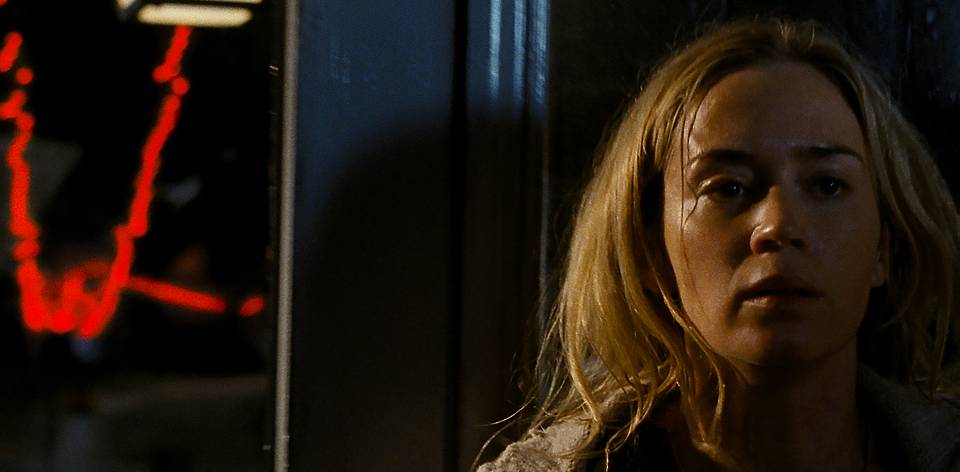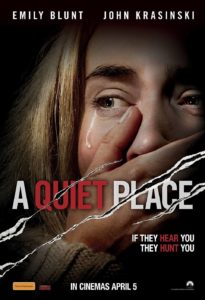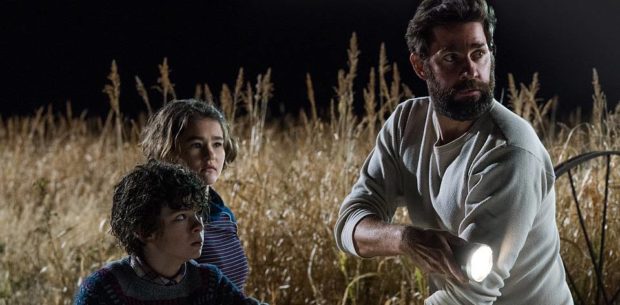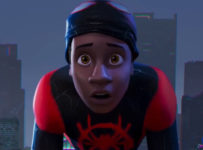Horror films are, at least on some base level, about robbing the victims of some sense of agency. In a typical slasher or monster pic, one’s own home is no longer a safe haven. In 2016’s Don’t Breathe, director Fede Alvarez gave a blind killer an advantage by plunging the young bodies into darkness. The loss makes the inevitable victory all the more satisfying. With John Krasinski’s A QUIET PLACE, the simple act of making any form of audible communication is taken away from a family. It proves to not just be a gimmick but rather the basis for a powerful and original thriller.
Krasinski and co-writers Bryan Woods and Scott Beck have set their film in the dystopian future of 2020. It’s an alternative future, but who knows what the world will look like by the next US presidential election. Monsters attracted sound to have sent the remaining humans into survival mode. Following a family tragedy, Evelyn (Emily Blunt) and Lee Abbott (Krasinski) hole up with their children Regan and Marcus (Millicent Simmonds and Noah Jupe) in a remote cabin. Complicating things, Evelyn is heavily pregnant, and newborn babies aren’t known for their hushed tones.
The concept of a silent thriller is hardly a new one, and indeed the first few decades of cinema mastered the art of scaring the bejesus out of audiences with the combination of light, shadow, and an orchestral score. So rather than thinking of A QUIET PLACE as a silent movie, it is better to consider it as one that uses sound judiciously. The absence of sound in a major modern film is deafening, even when it is filled in by Marco Beltrami’s shockingly present score. So when sounds do occur they are more shocking than the eventual monster reveal.
From a narrative point of view, every decision and moment on screen has to count. A heartbreaking scene at the start of the film involving a child’s toy is a prelude to disaster. A moment near a waterfall where a father and his son can express themselves provides joyous and temporary relief. A game of Monopoly uses felt tokens, but a lamp knocked over could be doom. More than anything, these moments are about exploring humanity with the sound turned down. How do you cry out, or weep for a loss, when doing so could mean your own death?
Characters do make some stupid decisions along the way, and you’d probably yell at the screen if you weren’t already deathly afraid of rattling your bag of Malteasers and attracting the creatures. In this way, Krasinski extends the feeling of helplessness and loss to the audience as well. It speaks to the careful environment in which the film was made, where the crew reportedly made as little noise as possible so as to pick up any diagetic sounds in the background.
Real-life couple Krasinski and Blunt are a formidable in the leads, at once familiar but wholly disappearing into their roles. There’s a moment when the duo dance to a tender song with headphones in, knowing that their reverie will not last. Blunt in particular gets a marvellous run in the back half of the film Wonderstruck‘s Simmonds, a young deaf actor who has to carry much of the film’s emotional weight, continues to prove that more representative roles can and should be written.
A QUIET PLACE is one of those rare horror-thrillers that people will continue talking about for months, and should be held up alongside Get Out and other recent genre outings as smart examples of what the mainstream has been missing out on. Ending with a cheeky play on the genre, restoring any hope the monsters took away. Yet there’s rarely a moment in this film when the characters are without their own agency. The script leaves the door open for more, but you can take this as near-perfect self-contained bubble. Now quietly make your way out of the cinema without making a sound.
[stextbox id=”grey” bgcolor=”F2F2F2″ mleft=”5″ mright=”5″ image=”null”]2018 | US | DIRECTORS:John Krasinski | WRITERS: Bryan Woods, Scott Beck, John Krasinski | CAST: Emily Blunt, John Krasinski, Millicent Simmonds, Noah Jupe | DISTRIBUTOR: Paramount (AUS) | RUNNING TIME: 95 minutes | RELEASE DATE: 5 April 2018 (AUS) [/stextbox]






